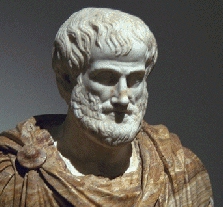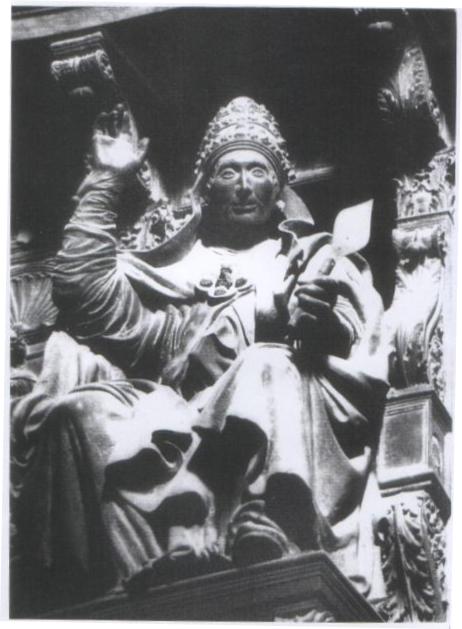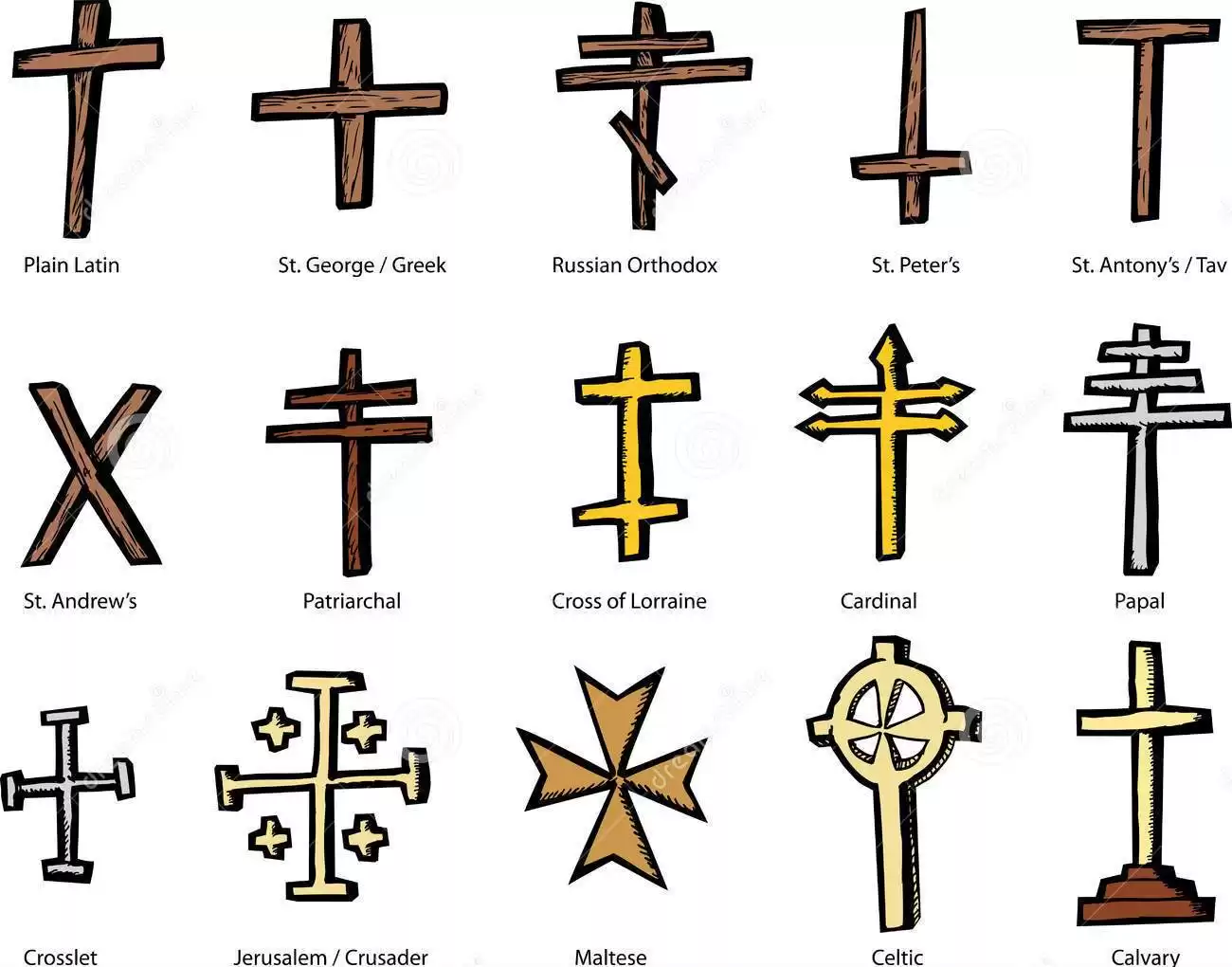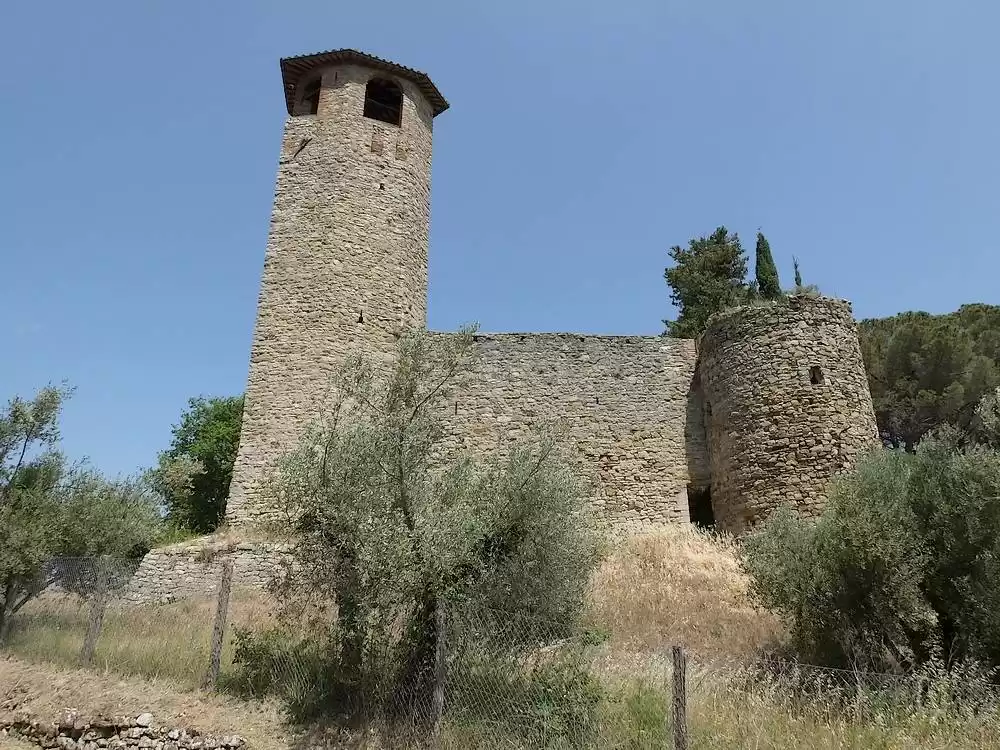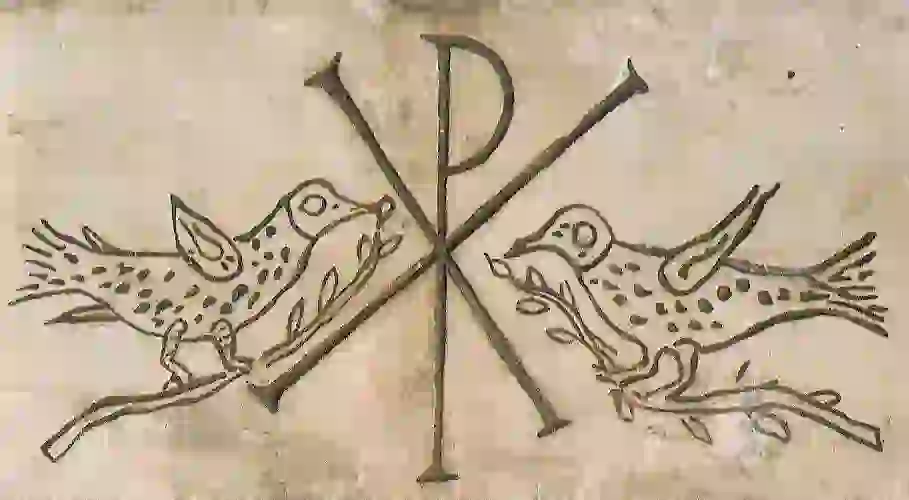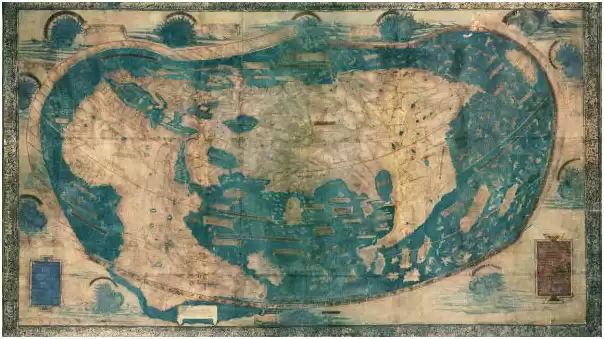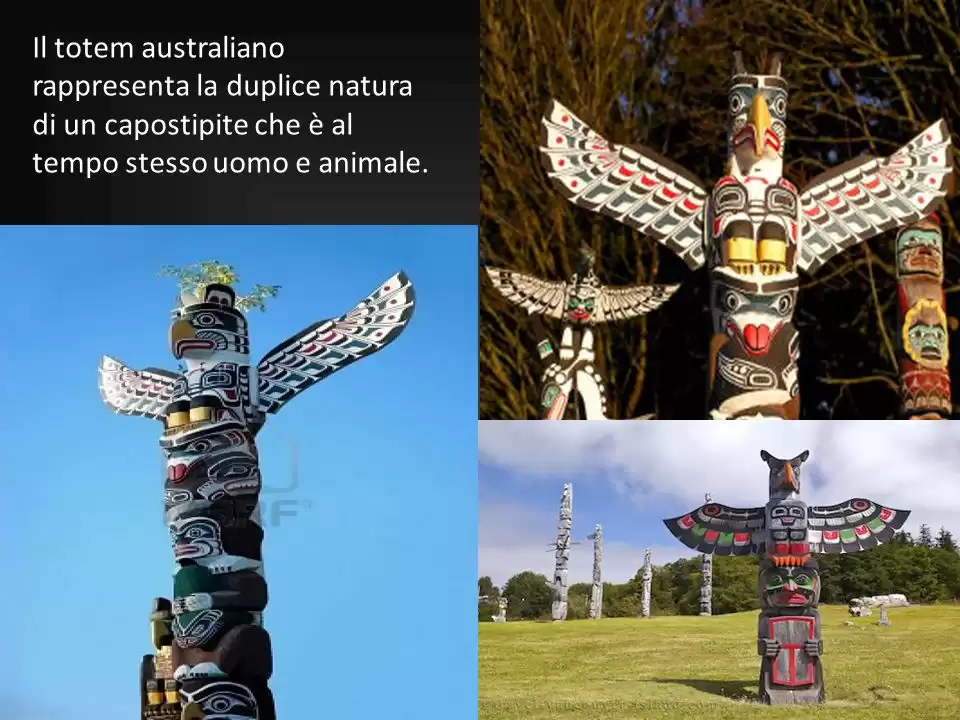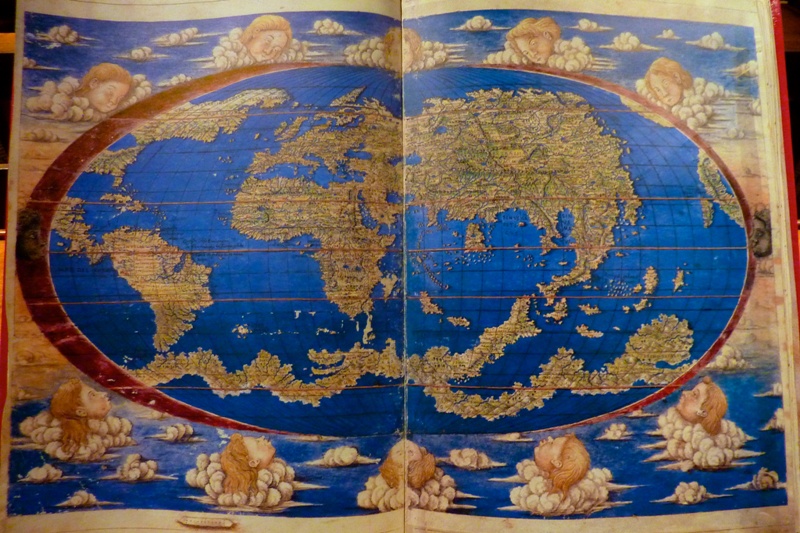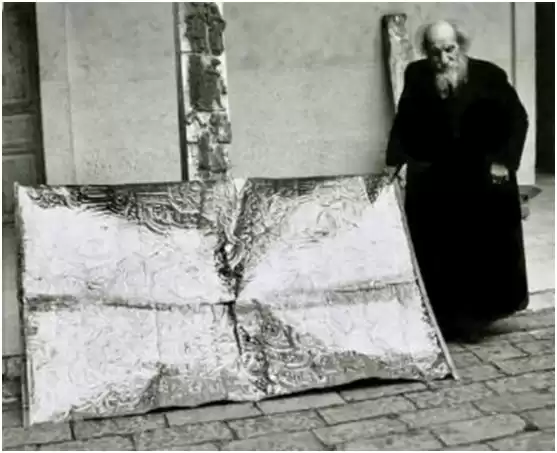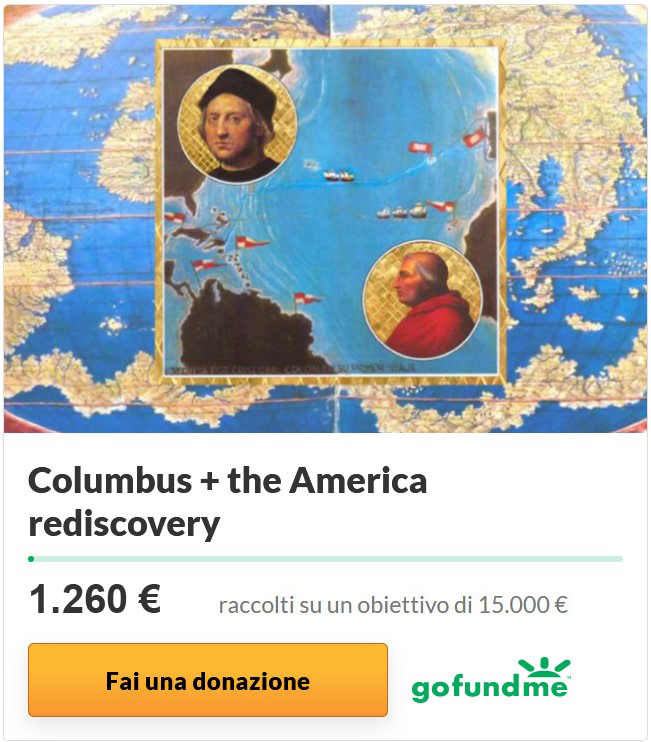
Christopher Columbus, the last Templar (Sperling & Kupfer, 2005)
Christopher Columbus, the last Templar (Destiny books and Inner Traditions International, 2007)
The Man that Surpassed the Boundaries of the World: Travels and Life of Christopher Columbus, the Hero that should have been made Saint (Sperling & Kupfer, 2010)
Review and critical commentary by Vincenzo Piazza, Ph.D.
INTRODUCTION
In his texts, Ruggero Marino invites us to rethink the image that has been transmitted to future generations regarding Christopher Columbus. In these books, his tenacious anti-conformist historical research pushes us beyond any preexisting boundary, giving to us a passionate narrative that “vanquishes,” one by one, all those myths that have been constructed regarding the Genoese admiral. Starting with the “great lie”, the one that still today is present in all history books, by which he arrives in the New World by error, in his attempt to circumnavigate the world and reach the extreme orient; which, at any rate, would have remained the goal of his successive explorations.
Nothing is more false: the Genoese is perfectly conscious of his objectives since the very beginning, and he is much more than a “simple” and “fortunate” man of the sea—actually, solid documentation tells us that he had reached the Floridian peninsula as early as 1485. Columbus moves on the basis of ancient maps with the heart and stamina of a missionary, of a soldier of Christ, with that same temperance that characterized the Chivalric Monastic Orders of the High Middle Ages, in particular, the most mysterious one, that of the Knight Templar—weren’t the knights reaching the “New World” as early as the 1230s from the secret port of La Rochelle in France and inundating the European market with silver? Columbus’ mission was that of evangelization of the idolaters; a religious and military mission. As a matter fact, his first voyage of 1492 is reported as an “armada”; an expedition similar to a crusade.
Columbus is a messenger, directly entrusted by Pope Innocent VIII, and like his messenger, will suffer that dramatic “damnatio memoria” (damned in memory) by means of tradition, to which will succeed the Spanish cardinal Rodrigo Borgia, the “prince of poison,” Alexander VI, that will eventually divide the world in favor of Spain. Marino—and scholars in Europe follow his indications—states, “Pope Giovanni Battista Cybo, Innocent VIII, is presumably also Columbus’ father.” Nevertheless, the admiral, Christo Ferrens (that’s how Columbus signed his name), will suffer the infamy of going back to Spain during his third voyage in chains, after which he will be freed by Catholic monarchs, Ferdinand and Isabel, to whom he had so devotionally entrusted his hopes; although, both will ultimately have a responsibility in the happening and in the falsification of history that will follow.
Marino will prove through documentation that Spain not only did not invest a “maravedis” in the voyage, and that all the capital to finance the exploit came from Vatican, Genoa and Florence—since Innocent VIII had ties with the wealthiest families of the “Superba” and was the father-in-law of the daughter of Laurence the Magnificent— but even the money needed by the Spanish monarchs to conquer Granada, came from Italy. The subsequent funding came after the fall of Granada, with the issuance of the papal Bolla for the crusade that the crowns of Spain were conducting against the Moors in Spain.
Eventually, Columbus will take to the sea more than once towards the New World; up to the fourth and extreme voyage, much like a new Ulysses; moved more so by strong Christian virtues rather than by the quest for wealth and adventure. After his death, came the silence.
For centuries, the figure of Columbus will be forgotten, it will be rediscovered in the 1800s, but still in our times, there is no indication of a complete and historic verity. Twice in the past 150 years, procedures for his beatification have been started, regularly interrupted, before taking into consideration the most important documents, so to certify his strong Christian character and moral conduct (Marino also includes an attachment in the appendix regarding the first attempt for beatification by Pope Leo XIII, dated July 16, 1892). Marino gives Columbus thousands of faces, ingenious navigator, hero without peace, cavalier of the sea, Templar, saint, and missionary; facets that will characterize the figure of Columbus in both texts, with a captivating prose; constantly engaging the reader with surprising hypothesis that is always supported by an extremely solid body of documentation—unprecedented when compared to other historians. Strong of this attitude and erudition, Marino launches the reader into a long voyage, rich with fascination and mystery, as if one is traveling side-by-side with Columbus himself.
Ruggero Marino opens both texts with following paragraph:
“Christopher Columbus discovered America on October 12, 1492, the day the world changed, and the modern era began. Columbus, a mariner of humble birth, is believed to be from Genoa, Italy, had left Palos, Spain), on August 3 of that same year. After years of persistence, Columbus had finally managed to convince the king and queen of Spain, Ferdinand of Aragon and Isabella of Castile, to support his undertaking. On the first voyage he sailed with three caravels, the Nina, the Pinta, and the Santa Maria, and crossed the Atlantic in a little more than two months. On his return, in January 1493, the pope, a Spaniard, Alexander VI, Rodrigo Borgia, placed the New World under Spanish sovereignty. Columbus made three more voyages to the Americas. He died in 1506 without ever truly knowing where he had landed, convinced that this territory was part of Asia. The name America was given to the New World in homage to the expedition of the Florentine Amerigo Vespucci.
Marino then continues…
“This story has been passed down for more than five hundred years. But the story has been corrupted, what we have today is the biggest lie of all times, and now the time has come to set the record straight, to upturn it like an old hourglass – the instrument that the navigator used to measure time.”
Personally, as a humanist and a historian, I must agree. The exploration of lands beyond Europe—of which Columbus’ voyage was to be the culmination—opened the entire world, thus introducing the modern age. The discoveries also undermined pontifical dogma on the character of the globe because the church fathers had always denied the existence of life at the antipodes. To the church, the Earth was seen as a sacred trinity: Europe, Africa and Asia. A new world and its inhabitants could have not descended from Adam, thus introducing yet another threat to medieval conviction. In simpler terms, one of the Church’s oldest teachings was that its view must be true because everyone believed in the divinity of Christ. That had been plausible in the Middle Ages, but now, as reports poured in from navigators, travelers, conquistadores and even missionaries, who were communicating to Rome news of a marvelous orient, the Europeans started realizing that other religions also flourished in newly discovered lands. Those Indians who worshipped alien gods there appeared to be none the worse for it. This new vision could have seriously questioned what the church had always predicated; therefore, the church had to manage the coming realization by sending one of his plenipotentiaries.
For Marino, and here too I am in agreement, it was not a case of claiming that Columbus missed the target out of simple foolishness. That is absurd because Columbus had already navigated along the coast of Cuba, for several months, in his second voyage; he was so close to the new world at that point that it would have been easier running into it than missing it. Therefore, a predecessor would have to be created for this eventuality. Yes, it’s Amerigo Vespucci, he was chosen as a convenience, a mercenary, a hired man— only for it to be discovered centuries later; a flaunted primacy in landing on the mainland was nothing but a great lie. Narratives continue to say “It was this Florentine explorer that reached Florida in 1497.” Subsequent studies would demonstrate this was not true, but by then it was too late. The fraud—for whose benefit if not Spain’s—had already overturned Columbus’ true legacy, and a false name would forever be given to the new lands. The destiny of the two Italian explorers, who had even been friends at one point, was separated forever.
Here’s a list of what can be call “conjectures” made by renowned historians (names I will leave anonymous). For example, among historians, famous remains the story of the Aristotelian concept of the world to which Columbus was quite attached to. The existence of India and Spain was known in ancient Athens. Aristotle made an error however, although, he embraced the concept that the world is spherical. Holding that land is heavier than water, and the masses of each must balance, he had inferred that the distance between the Iberian Peninsula and the Indian subcontinent could not be great, and that, consequently, there was no land between them: no North or South America.
Therein lay the origin of Columbus’ error, alleges one renowned historian—close to ridiculous, and yet embraced by many scholars.
Another historian brings into the scene the Alexandrian scientist Ptolemy and Hipparchus, whose theories flourished four centuries after Aristotle. True, Ptolemy concluded that the Earth’s circumference was 25,000 nautical miles (surprisingly accurate), but he inferred in his Geographike Hyphegesis (Guide to Geography), which greatly influenced Medieval geographers, that Asia extended much farther east than it actually does. Here again, the historian alleges that those who were misled included Columbus, and therefore his belief that Asia could be reached by sailing westward was consequently strengthened. He continues by stating that any doubts in Columbus’ mind were cleared by another text known as the Imago Mundi, a comprehensive work of geography by Pierre D’Ailly, a fourteenth-century cardinal and master of the college of Navarre. D’Ailly took the Aristotelian view that Europeans could reach India by sailing westward. The Imago Mundi, the historian states, became Columbus’ favorite bed-side book. I repeat bed-side book; terminology which is not only lascivious but is also offensive, especially to a highly-educated man like Columbus who graduated from the University of Padua, where he also taught—in seven languages fluently, including Arab. In addition, Columbus was a cartographer, a friend of the great physicist Toscanelli—who pushed him toward the great mission—and also an intimate friend of a great humanist and cartographer, the cardinal Cusano.
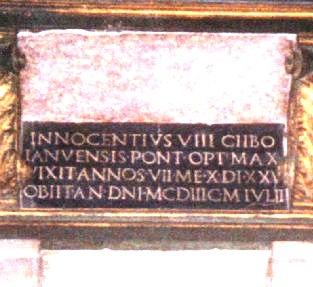 In fact, the most important and earliest map we have of the New World was produced by Piri Reis, admiral and cartographer of the Ottoman imperial fleets; his pre-modern world map compiled in 1513 is an incontrovertible testimony to the genius of Columbus. He includes the New World, both continents. What reason would he (an Islamist) have had to mention the Christian Columbus and attribute merits to him? Piri Reis wrote of only two boats (two caravels), but on the 1492 voyage, there were three boats (a carrack and two caravels)—another error made by historians. Perhaps, the Turkish admiral was referring to a previous voyage that Columbus must have made between 1485-1487 or perhaps another voyage between 1490-1491; as the popal-historian Panvinio states (?) Even according to some scholars, they state that there were only two caravels on the first voyage, and there still is no consensus on the names of the vessels. Certainly, there were other voyages, secret ones, according to Piri Reis, as well as to Marino. In short, the Turkish admiral’s maps show the Azores, the Canaries, Madeira, and incredibly, Antarctica. Most of all, the giant lands of Cipango-Antilles—words, note well, that pertain to pre-Colombian languages, present in Marco Polo’s opera that was read and checked by Columbus—which correspond to Columbus’s own words in his naval diaries; yes, what today are the Americas.
In fact, the most important and earliest map we have of the New World was produced by Piri Reis, admiral and cartographer of the Ottoman imperial fleets; his pre-modern world map compiled in 1513 is an incontrovertible testimony to the genius of Columbus. He includes the New World, both continents. What reason would he (an Islamist) have had to mention the Christian Columbus and attribute merits to him? Piri Reis wrote of only two boats (two caravels), but on the 1492 voyage, there were three boats (a carrack and two caravels)—another error made by historians. Perhaps, the Turkish admiral was referring to a previous voyage that Columbus must have made between 1485-1487 or perhaps another voyage between 1490-1491; as the popal-historian Panvinio states (?) Even according to some scholars, they state that there were only two caravels on the first voyage, and there still is no consensus on the names of the vessels. Certainly, there were other voyages, secret ones, according to Piri Reis, as well as to Marino. In short, the Turkish admiral’s maps show the Azores, the Canaries, Madeira, and incredibly, Antarctica. Most of all, the giant lands of Cipango-Antilles—words, note well, that pertain to pre-Colombian languages, present in Marco Polo’s opera that was read and checked by Columbus—which correspond to Columbus’s own words in his naval diaries; yes, what today are the Americas.
RUGGERO’S QUOTES
In the following passages, you have the author expressing his thesis in a provocative synthesis. Marino starts by setting a comparison of events from Columbus’ time period to our time period in order to present the false sense of history as it was passed down to us:
Columbus, the true discoverer of the Occident
Imagine today, in full modern times, in full twenty-first century, in the most democratic country in the world, in the home of the “self-made man,” a Mexican immigrant walks across the boundary line and after having been received by Putin (the other great oceanic power of the fifteenth-century during Columbus’s times was Portugal) pretends now to meet President Obama and is able to…well, let’s put it this way, if this individual would begin a conversation with the president of the United States of this type…”I know about other lives and other worlds rich with gold, pearls, of precious stones and even more, please give me three space shuttles after which, upon my return, I will be appointed vice-president of all those worlds, I will have jurisdiction on them and I will receive 57% of the gains (this is the amount Columbus had negotiated with the Spanish royals, according to archival documentation of the fiscal capacity of the Spanish monarchs in the “Pleitos Colombinos”)…if today Obama would give his consent and would remit to this adventurer “carta Bianca” would this “antiquated joke” be credible?” This, my friends, is what incredibly they have taught us during the last 500 years, in a history written, like never before, by the victors, a story of the greatest theft of history!
Ruggero Marino continues:
Is it possible to believe in this when in the late 1400s emperors were emperors, and kings were kings and a “humble” sailor like Colombo would have ended up on the stake for such pretensions? How was Columbus able to knock and open the doors of all the great European courts? Columbus is an intimate of the King of Portugal which he even “reprimands” when he comes back from his discovery. He then goes to the Spanish royals and imposes on them his diktat down to the last comma, that is, the mighty royal couple, Isabel and Ferdinand, that were in the meantime “bending” the great nobles of Spain, and expelling the Jews and the Muslims. Columbus, before the first “no” of the Spanish royals, he decides to visit France, while his brother is already a favorite at the court of the English monarch. Columbus marries in Portugal a noble relative of the royal family (how could a “humble” sailor, as he has been depicted, be able to do this?), he dialogues with three popes, and dictates to Pope Alexander VI, the Borgia pope, how to divide the world in two with the “raja.” He is in constant contact with Toscanelli, one of the most prestigious minds of the time that lives in Florence, then under the domain of Lorenzo the Magnificent. What Columbus is able do is better than “Batman’s” exploits!
Who was, therefore, Christopher Columbus? It’s more than 500 years that we interrogate ourselves on this mysterious personage. Is he discoverer, a mariner recognized beyond his merits, a fortunate discoverer in a case of “serendipity,” or something more, much more, in an event that calls to be revisited from a totally different interpretation? Why did he author himself on documents as Christo Ferens, in an esoterically cryptogram of a Grand Master, never really decoded, or better “Bearer of the Christ?”
 Based on this premise Ruggiero Marino proposes a new edition of the human events, public or private of Christopher Columbus, based also on recent documents, in order to reconstruct a more veritable portrait of the “admiral of two worlds.” In an “identikit” that moving from one of his most revolutionary phrases, revealing and yet contemporary of the great admiral: “The Holy Spirit is present in Christians, Muslims, and Hebrews”; for a dream of universal peace between the three great religions of the book. For a mystic and a scientist that in the “Book of Prophecies”, that few know and many prefer to ignore, because it doesn’t reflect the traditional portrait of an “ignorant mariner, Columbus writes, “who knows how to read and write does it in four different ways”. Just like Dante. In a final analysis, Columbus demonstrates that his intellectual stature is of an interpretation that belongs to cabalistic thought.
Based on this premise Ruggiero Marino proposes a new edition of the human events, public or private of Christopher Columbus, based also on recent documents, in order to reconstruct a more veritable portrait of the “admiral of two worlds.” In an “identikit” that moving from one of his most revolutionary phrases, revealing and yet contemporary of the great admiral: “The Holy Spirit is present in Christians, Muslims, and Hebrews”; for a dream of universal peace between the three great religions of the book. For a mystic and a scientist that in the “Book of Prophecies”, that few know and many prefer to ignore, because it doesn’t reflect the traditional portrait of an “ignorant mariner, Columbus writes, “who knows how to read and write does it in four different ways”. Just like Dante. In a final analysis, Columbus demonstrates that his intellectual stature is of an interpretation that belongs to cabalistic thought.
Innocent VIII and the navigator
Strange analogies, revealing similarities, in a sort of parallel lives, can be viewed between Columbus and the Greco-Genoese pope Innocent VIII (ignored until 1990, when Marino’s research began, also by the Italian historians). Giovanni Battista Cybo was first Bishop of Savona, in the period in which Columbus sojourned in that city. Cybo then is elected to the Throne of Peter in 1484 in the time of the great astrological conjunctions (astrology at that time was like a second faith) between Mars and Saturn: they predicted, in a millenarianism certainly more profound of that same millennium, incredible changes in the course of humanity and in the religion. Always in 1484, Columbus moves from Portugal to Spain. Innocent VIII dies July 25, 1492, day in which today Christianity celebrates the day of Saint Christopher! The Pontiff will die exactly seven days before the departure of Columbus, with a revealing punctuality, when the poison of the Borgia family was running like a river of Coca Cola! When he returned from his first voyage, Columbus advanced an incredible request to the Pope not knowing that he had already passed: to make his teenage son Diego, a Cardinal, as Innocent had done before, by making cardinal the teenage son of Lawrence the Magnificent, soon to become Pope Leo X. Succeeding Innocent VIII will be a Borgia pontiff, the Spanish Alexander VI, prince of poison. It will be him, “elected through the intrigues of Spain” (so the French historian Pierre Chaunu wrote) to give the newly discovered lands to Isabella of Castiglia and Ferdinand of Aragon.
The name Columbus itself means also “son of the Holy Spirit.” In fact, more than an element makes us think that he might have Pope Innocent’s blood-line, if not an illegitimate son of the pontiff, at least a nephew. Two documents define Columbus as “nepos.” It was a keen manner by which the Curia used to often mask the paternity of popes. Prior to having embraced the ecclesiastical career, Giovanni Battista Cybo produced several children, two had been recognized, and rumors have it of over 12 children that have remained in the shade. His son Franceschetto will openly marry the daughter of Lorenzo the Magnificent, which, together with the banker Giannotto Berardi will be one of the financiers of the voyages and also partner, up to his mysterious death, of Columbus.
Columbus’s sponsors
The money given to Columbus was renowned to be half Italian (Genoese and Florentine), obtained through the “sponsoring pope” with his network of parentages and through the pope’s men present at the Spanish court. A document recently discovered demonstrates the “ecclesiastic” origin of the portion of money utilized by the Spanish crowns. They came from the crusading fund against the Moors instituted by Pope Innocent VIII. They were funds belonging to the Church of Rome. The Church, together with Columbus and Innocent VIII, endeavored for a universal design: a geographical sphere as well as spiritual, “Since this discovery—these are the exact words of Bartholomeo de Las Casas—was one of the most valorous enterprises that God had intended to realize for the world, since He had wished men to discover such a vast world and a part of the universe—the major part, this we believe, up to then so much hidden and secret—where he would have wanted to expand his sacred Church and maybe altogether transfer it to this new place itself…”; this, intended by Las Casas, to the New World.
The Pope’s Family
The pope was the son of Aronne (Jewish blood) born in Rhodes, the island of the “sea cavaliers,” and nephew of a Saracen (Muslim blood). In his blood was concentrated the blood of the three major world monotheist religions for a dream of a universal peace or, if that wasn’t possible, in the endeavor for a future crusade against the Ottoman with the gold of the Indies (the New World). After the conquest of Constantinople (1453) on behalf of the Turks—by many, considered a tragedy far superior to the collapse of the Twin Towers in 2001—Rome was in the pursuit of the Sacred Lands, and all popes elected from that very moment embraced the reasonability to organize a crusade. In a vision that can be viewed alchemic altogether, for the year 1500 (coinciding with the Jubilee) Columbus promised in one of his letters the realization of a crusade for the re-conquest of Jerusalem and the beginning of a new golden age. However, no chances were left for an agreement between the Sultan and the Christian world, which had already been explored by several popes prior to Innocent VIII.
The cavalier Columbus
 Columbus is a soldier of Christ, he’s half monk and half cavalier (almost always he is described in this manner), a knight, a crusader. Certainly, heir to Templar designs as well. The cross on his sail is red on a white background; the shape could also be that of the cross used by today’s Cavaliers of Malta (in the Middle Ages, of Rhodes). Other crosses look like those of the Sacred Sepulcher, and a green cross with which he set foot on the new world dates back to that of Saint Lazarus. On the other hand, a crusade against the Moors was being launched by the Spanish. In this atmosphere, it’s Innocent VIII that nominates Ferdinand and Isabel “Catholic monarchs”—there are no historians mentioning it, thus giving erroneously the concession to Alexander VI—and finances them as well. Innocent VIII then proceeds in uniting the remaining Chivalric Orders for a future, more prominent crusade. The voyage programmed by Columbus and financed and organized by Innocent VIII can be viewed in the same lieu: the evangelization of the idolaters of the Indies. The “Catholic monarchs” have been entrusted by Innocent VIII to bring forth the cross for the evangelization of the pagans of the new world. In fact, in the documentation, the three caravels (actually, Marino proves they were only two, the third, the Santa Maria, was a full-scale ship), are mentioned as an Armada…a military operation. Admiral Columbus would never have attempted to reach China and Japan with three ships
Columbus is a soldier of Christ, he’s half monk and half cavalier (almost always he is described in this manner), a knight, a crusader. Certainly, heir to Templar designs as well. The cross on his sail is red on a white background; the shape could also be that of the cross used by today’s Cavaliers of Malta (in the Middle Ages, of Rhodes). Other crosses look like those of the Sacred Sepulcher, and a green cross with which he set foot on the new world dates back to that of Saint Lazarus. On the other hand, a crusade against the Moors was being launched by the Spanish. In this atmosphere, it’s Innocent VIII that nominates Ferdinand and Isabel “Catholic monarchs”—there are no historians mentioning it, thus giving erroneously the concession to Alexander VI—and finances them as well. Innocent VIII then proceeds in uniting the remaining Chivalric Orders for a future, more prominent crusade. The voyage programmed by Columbus and financed and organized by Innocent VIII can be viewed in the same lieu: the evangelization of the idolaters of the Indies. The “Catholic monarchs” have been entrusted by Innocent VIII to bring forth the cross for the evangelization of the pagans of the new world. In fact, in the documentation, the three caravels (actually, Marino proves they were only two, the third, the Santa Maria, was a full-scale ship), are mentioned as an Armada…a military operation. Admiral Columbus would never have attempted to reach China and Japan with three ships
…and do what with three ships…conquer the Orient! It would have been, by reaching the extreme orient with an “Armada,” a declaration of war. If Columbus were directed towards China, it was to search for alliances, not evangelize a civilization, which for the most part, was superior to that of Europe, and certainly more powerful; maybe an alliance for the final defeat of the Muslims; a design that goes back to Marco Polo’s experience at the court of the Great Khan. In fact, Columbus’s gifts are not ornate objects of silver and gold, bombards and iron weapons, nor refined pieces of artwork produced by Italy—gifts that would be just fit for a great Chinese emperor—but articles of curiosity fit for a primitive, idolatry, pagan people, such as the Indians that he will encounter in the archipelagos: glass marbles, cloth standards with images of Christ, wooden and metal crosses, checker boards, cookies (gallette), etc.
Columbus and the American Indies
Columbus had always sustained that he had arrived in the Indies. And he wasn’t mistaken. The interpretation of modern historians, in fact, is incorrect. Columbus knew well that what he had discovered was a new world, but only in part known to the ancients, that didn’t have anything to do with Asia. As Marco Polo himself knew, written it down in his opera “Il Milione:” it isn’t surprising that Columbus was an arduous reader of Polo’s memoirs, making reference to the Venetian merchant many times in his writings. Japan had not yet been discovered, the “Cipango,” just by reading Polo’s interpretation, with its anthropophagi and the distance of the Pacific Ocean to cover in no less than an year’s navigation, can only be the Americas (utilizing from the departure to the return the monsoonal winds). The Chinese, on the other hand, had already reached the new world intended as Cipango (1421), but never in Japan. China has attempted more than once to conquer and occupy Japan, but was never successful. The denominations of words in “ango” are typical of Mesoamerica (Xipangu, Durando, Cilipancingo, Chicicastenango…etc. (as Marino states), are not found on Chinese geographical maps. The maps, by which Columbus used to launch his explorations, were in custody in the Vatican library (son of Pope Innocent VIII, he had access to them like no other explorer!). Some, according to witnesses, date back to the library of Alexandria, Egypt, or earlier times. Columbus knew perfectly well where he was going and where he would have landed. His first voyage, as the famous map of the Turkish sailor-cartographer Piri Reis attests—preserved at the Topkapi museum in Istanbul, took place during the pontificate of Innocent VIII, before 1492. On the pope’s tomb in St. Peter’s Basilica in Rome, commissioned to the artist Pollaiolo, we read: “Novi orbis suo aevo inventi Gloria” (In the time of his pontificate the discovery of a new world”). Various historians confirm this. Maybe, in a preceding time, father and son or nephew might have sailed together, since the great papal historian Pastor defines Innocent as “the great mariner pope”? Other maps, where there appears Florida before the expedition, clearly speak of “predescubrimento” (pre-discovery). It’s not a coincidence that even the “raja” will be moved in a manner to give Brazil—that evidently had already been touched prior to 1492—to Portugal. And there are several elements to suppose that this is true, as many historians do reveal today.
Papacy and Columbus in the XIX Century
Two popes of the nineteenth century have tried to make Columbus a saint. We are looking at Pious IX and Leo XIII. Their words in regard to Columbus are incredible. Pious IX started the process of beatification, against all ecclesiastical rules, since they are missing, due to the passage of three centuries, “the direct living witnesses and the bishop in loco” to begin the case. Leo XIII writes an encyclical clearly produced for whom has already been beatified. Among many things, he affirms: “Columbus is ours, what he has done, was done for the Church”. When Columbus, on his return from his third voyage was put into chains, he was wearing the tunic of a Franciscan; he will wear it also in death.
The esoteric signature of Columbus
Singular analogies build a conductive filament between our times at the turn of the second millennium and the Jubilee and what had happened 500 years ago. The clash between East and West, was similar to our contemporary times, including slaughters. There was also an assassination attempt on Pope Innocent VIII by a Turk (just like John Paul II). Spain, nevertheless, won the “game” and re-wrote history, but the elements of what can be viewed as a plot that lasted five hundred years have come back to the surface to haunt those that have misinformed us (for this reason, we advise to refer to our four publications). Altogether, Marino’s dedicated research, in a Renaissance lieu, presents to us a picture which is totally different than the one presented to us for more than 500 years. This means that the time has come to give a totally different, unprecedented, interpretation of Columbus’s famous and enigmatic cryptogram composed of seven capital letters—a triangle like the eye of God, and in one of the four interpretations, reveals the letters X M Y and the successive signature Xpo Ferens; in simpler terms, Christ, Muhammad, and Yaweh, “bringer of Christ;” because the Holy Ghost, as the admiral explains several times in his memoirs, is present in Christians, Jews, and Muslims. For a man, a knight, a Christian, probably a “heretic” of great unimaginable views, this is the Columbus that makes sense, and that Marino intensely describes. His work brings justice to an event that has been deformed by purges and by lies, which was the only means by which the Spaniards could impudently put their hands on the riches of the Americas, and also, to attribute to a simple salaried sailor, Amerigo Vespucci the glory of the scientific approach to the new continents.
The many protagonists

Based on all these elements we can with all tranquility ascertain that if it wasn’t for the voyage of the “Christian” Columbus (of Jewish and Muslim blood as well) America would have been colonized by the Chinese (officially arriving in North America in 1421) or by the Muslims (which possessed the ultimate maps in regard). Both these civilizations possessed the same maps as Columbus and they controlled great fleets, superior to those of the Christians by far. America, therefore, must be, and more than anything, thankful to the Christian Christopher Columbus if today it hasn’t shaken above its head Mao’s Red Book or bowed towards the Mecca!
The author: Ruggero Marino
Ruggero Marino is a retired journalist who was special envoy and chief editor of Il Tempo (a major newspaper in Rome), and worked under the direction of Gianni Letta. He was responsible for the cultural editorials published in the famous Roman daily journal. Marino is the author of the book Christopher Columbus and the betrayed Pope, published in four editions: 1st through 3rd (Newton Compton, 1991), 4th (RTM Multimedia, 1997). The fourth edition is adjourned and expanded, with an introduction by Prof. Franco Cardini. Marino also wrote Christopher Columbus, the Last of the Templars (Sperling & Kupfer and Rai Eri, 2005). The text has been translated in seven countries, including the US and Canada. Marino’s lastest text on Christopher Columbus, L'uomo che superò i confini del mondo (English: The Man who surpassed the Boundaries of the World) (Sperling & Kupfer, 2010) won the Culture of the Sea prizeand was a finalist in the Premio Acqui Storia (Acqui Award of History) competition; a provocative theatrical version of the text was also produced. Marino was a member of the Commissione Scientifica per le celebrazioni in occasione del Cinquecentenario della morte di Colombo (English: Scientific Commission and National Committee for the celebration of the 500th Anniversary of Christopher Columbus); it was presided over by former Italian minister Claudio Scajola.

